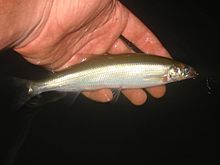Smelty
| Smelty | ||||||||||||
|---|---|---|---|---|---|---|---|---|---|---|---|---|

Arctic smelt ( Osmerus mordax ) |
||||||||||||
| Systematics | ||||||||||||
|
||||||||||||
| Scientific name | ||||||||||||
| Osmeriformes | ||||||||||||
The smelt-like (Osmeriformes ( Gr .: osme = bad smell + Lat .: forma = shape)) are an order of the real bony fish (Teleostei). They live on the northern hemisphere of the earth as well as in New Zealand , Tasmania , in the southeast of Australia and on the Chatham Islands in cool and temperate regions in brackish and fresh water, some species also temporarily in the sea. Only a few species from the Salangidae family also occur in tropical areas. With the exception of the European smelt ( Osmerus eperlanus ) and possibly one or two species of salangid, all smelt-like spawn in freshwater.
features
Smelt-like are slender, elongated fish and grow to be 5 to 40 centimeters long. The back of the vomer is short. Basis phenoid and orbitosphenoid (two skull bones) are missing. Teeth on the mesopterygoid, a bone between the pterygoid ( wing bone ) and metapterygoid, are reduced. An adipose fin may be present or absent. The scales are devoid of concentric growth rings.
External system
The smelt-like were formerly placed in the sub-cohort Protacanthopterygii together with the salmon-like (Salmoniformes), the order of the golden salmon-like (Argentiniformes) and the pike-like (Esociformes) , which were formerly part of the smelt-like order . According to new studies, however, they are the sister group of the Maulstachler (Stomiiformes), an order of sometimes bizarre-looking deep-sea fish. Therefore, in the latest revision of the bony fish system, they are separated from the Protacanthopterygii and instead form the sub-cohort of the stomiati with the mouth spines .
Phylogenetic position of the smelt-like:

| Euteleosteomorpha |
|
||||||||||||||||||||||||||||||||||||||||||
|
|
Internal system
The smelt-like are divided into two sub-orders , four families , 14 genera and about 40 species . The former suborder Argentinoidei (with which the smelt-like cucumber odor occurring in several species in common), the family of galaxies and the Western Australian salamander fish are now managed in separate orders ( Argentiniformes , Galaxiiformes and Lepidogalaxiiformes), so that only four families are left with the Smelt-like remained.
- Suborder Osmeroidei
- Smelt family (Osmeridae)
- Ayu family (Plecoglossidae)
- Family Salangidae
- Subordination Retropinnoidei
- New Zealand salmon family (Retropinnidae)
Tribal history
The late Cretaceous carnivorous and marine genus Spaniodon is possibly the oldest smelt-like fish. The recent genus Osmerus is already fossilized from the Miocene , Mallotus only from the Pleistocene .
Hazardous situation
The International Union for Conservation of Nature IUCN has 5 species of the order Smelt-like in the Red List of Endangered Species . Here the species Hypomesus transpacificus is designated as endangered ( Endangered ), another 3 species are not considered to be endangered ( Least Concern ) and one species is not assessed due to insufficient data ( Data Deficient ).
literature
- Joseph S. Nelson : Fishes of the World. 4th edition. John Wiley & Sons, Hoboken NJ et al. 2006, ISBN 0-471-25031-7 .
Individual evidence
- ↑ a b c R. Betancur-R., E. Wiley, N. Bailly, A. Acero, M. Miya, G. Lecointre, G. Ortí: Phylogenetic Classification of Bony Fishes - Version 4 (2016)
- ^ Karl Albert Frickhinger: Fossil Atlas Fish , Mergus-Verlag, Melle, 1999, ISBN 3-88244-018-X
- ↑ Osmeriformes in the IUCN Red List of Threatened Species 2009. Accessed March 5, 2010.
Web links
- Smelty on Fishbase.org (English)

